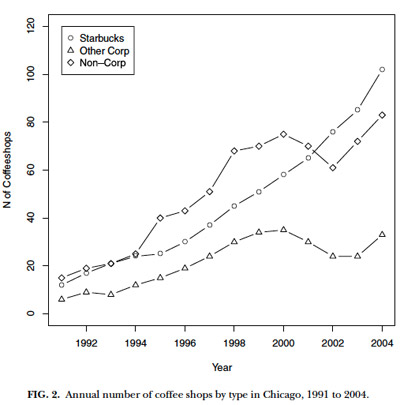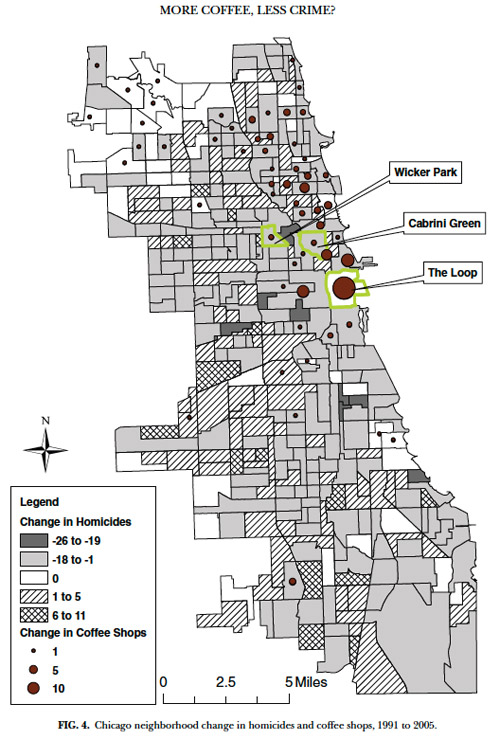
Awhile back I definitively proved that the problem with the Illinois legislature is a lack of coffee. Could more coffee help Chicago? That's one of the questions raised by "More Coffee, Less Crime? The Relationship between Gentrification and Neighborhood Crime Rates in Chicago, 1991 to 2005" (PDF), a paper by Andrew Papachristos—a Loyola grad and Chicago native who's written lots of interesting stuff on urban crime and policy—and colleagues. I'd been meaning to read it since it came out last year; I tend to consume coffee, data, and policy in bulk.
There's a lot of neat stuff involved in getting there, but the answer to the question posed by the title shouldn't surprise: "With regards to homicide, more coffee does equate with less crime—and the effect is similar for both White and Black neighborhoods."
One of the more interesting findings, however, is that the effect isn't uniform across crimes, however: "As with homicide, coffee shops have a negative effect on robberies in White and Hispanic neighborhoods. In majority Black neighborhoods, though, we find the opposite effect: coffee shops are associated with higher levels of robbery."
Come again? The authors argue that it's because of differing intra-racial gentrification patterns: "Black gentrifying neighborhoods in Chicago tend to be spatially proximate to other high-crime Black communities and, thus, do not receive the same ecological benefits of White/Hispanic gentrifying neighborhoods." Not to mention that more people with money next to high-crime areas means more appealing and practical targets for robbers. It's a limited piece of data, but it does suggest some of the difficulties in maintaining stability in black neighborhoods versus white and Hispanic neighborhoods.
It's also a good read based on its raw data. The graph of Starbucks vs. other chains vs. indie coffee shops surprised me a bit. Indie coffee shops actually outpaced Starbucks in Chicago from 1992-2001, and then Starbucks—the growth of which was remarkably close to linear—surpassed it in 2001, when the number of indie shops went into a sudden decline (my guess would be because of the post-bubble/9-11 recession).

That near-linear growth: that's what capital will do for you.
The other is a homicide and coffee shop map, showing the growth and decline of both from 1991-2005. Conveniently, this timeframe is a critical one in the annals of Chicago crime. In 1991, homicides broke the 900 mark and remained there for four years. In 2004, there were fewer than 500 homicides for the first time in decades. (I say "conveniently" because that happens to be part of what Noah Isackson wrote this week in his profile of Garry McCarthy.) And as the graph above indicates, there was a substantial growth in the number of coffee shops in the city.
So even if you're only interested in crime or coffee, it's an interesting map. It turns out there's sort of a coffee-shop belt spreading northwest from the Loop.

In part, it's a good map because it demonstrates the geography of Chicago's massive decline in homicides—and how, like coffee shops, it was not evenly distributed across the city.


